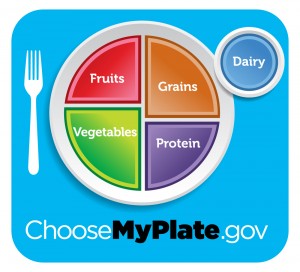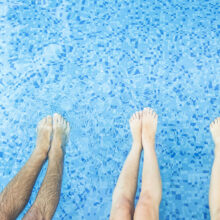Portion Control: Tips to Manage Weight & Eat Better
- Published: Wednesday, January 18th 2012
- in Living Well
 The misconception of “bigger is better” is leading Americans down a road of obesity and diabetes, and while part of this problem is the content of the food itself, portion sizes contribute to the issue just as much.
The misconception of “bigger is better” is leading Americans down a road of obesity and diabetes, and while part of this problem is the content of the food itself, portion sizes contribute to the issue just as much.
We’ve all seen the articles that match portion sizes of veggies, meat and more to relatable items such as a computer mouse, a deck of cards or a tennis ball, but how many of us can actually catalogue these food groups with their corresponding product in our minds to apply when we’re sitting down at a meal?
The USDA has made things easier with its MyPlate tool, which is based on the 2010 Dietary Guidelines for Americans to  help consumers make better food choices. Designed to remind Americans to eat healthfully, MyPlate illustrates the five food groups using a familiar mealtime visual: a place setting. When you plate your food, or go out to eat, it’s good to keep the MyPlate visual in mind; fruits and veggies should take up at least half of your plate, grains should take up more than a quarter of your plate and protein, a little less than one quarter.
help consumers make better food choices. Designed to remind Americans to eat healthfully, MyPlate illustrates the five food groups using a familiar mealtime visual: a place setting. When you plate your food, or go out to eat, it’s good to keep the MyPlate visual in mind; fruits and veggies should take up at least half of your plate, grains should take up more than a quarter of your plate and protein, a little less than one quarter.
We know that the idea of eating less may sound daunting to many people, us included at times. Here are some tips from Choosemyplate.gov to understand just how much you are eating and why, along with a few common obstacles people face and ways to get past these concerns.
- Figure out how big your portions really are: Measure how much the bowls, glasses, cups and plates you usually use hold. Pour your breakfast cereal into your regular bowl. Then, pour it into a measuring cup. How many cups of cereal do you eat each day?
- Measure a fixed amount of some foods and drinks to see what they look like in your glasses and plates. For example, measure one cup of juice to see what one cup of liquid looks like in your favorite glass.
- Pay attention to feelings of hunger. Stop eating when you are satisfied, not full. If there is still food on your plate or on the table, put it away (or throw it out). Repeat the phrase “a moment on the lips, a year on the hips” as you do this.
- A simple trick to help you eat less is to use a smaller plate, bowl or glass. One cup of food on a small plate looks like more than the same cup of food on a large plate.
- It is important to think about portion sizes when eating out. Order a smaller size option, when it’s available. Manage larger portions by sharing or taking home part of your meal. When Eating Out, Make Better Choices has lots of tips to help you eat only the amount you need when eating out.
- If you tend to overeat, be aware of the time of day, place and your mood while eating so you can better control the amount you eat. Some people overeat when stressed or upset. Try walking instead of eating, or snack on a healthier option. For example, instead of eating a bag of chips, crunch on some celery, or instead of eating a bowl of ice cream, enjoy a low-fat yogurt with fresh blueberries. Making healthier choices is better for your weight and can also help you feel better.
Common hesitations:
1. “I don’t have time to measure out my foods all the time.”
Being successful at decreasing portion sizes doesn’t mean that you have to measure every meal or snack you eat. Once you’ve taken the time to measure out a few examples, you will be able to estimate portion sizes better. Plus, just eating or drinking less than you normally would means you are decreasing your portion sizes.
2. “My Daily Food Plan tells me to eat more of some things but also to decrease portion sizes. I don’t understand if I should eat more or less.”
The recommendation to decrease portion sizes is particularly important for high-calorie foods or for foods with a lot of empty calories , such as cakes, cookies, sugary drinks and pizza. It is important to Focus on Foods You Need. For example, eat a large portion of steamed broccoli (but with only a very small amount of butter or cheese sauce, if any).
3. “I like to eat a big burger every once in a while. Are there other ways to eat less?”
In general, it is a good rule to eat and drink smaller portions. You can occasionally eat or drink foods in larger portions, but not as part of your daily diet. Make that big burger a “once-in-a-while” special treat, and on most days choose the smaller options.
4. “I was always told to clean my plate.”
Resign from the “clean your plate” club now. Stop eating when you are satisfied, not when your plate is empty. Start your meal by only eating half of what’s on your plate. Stop for a moment and decide if you really want to eat more. Don’t forget that you can save some leftovers for another meal or snack. Learn more about keeping food safe to eat. Nothing has to go to waste, and the food will taste better when you are hungry again!


